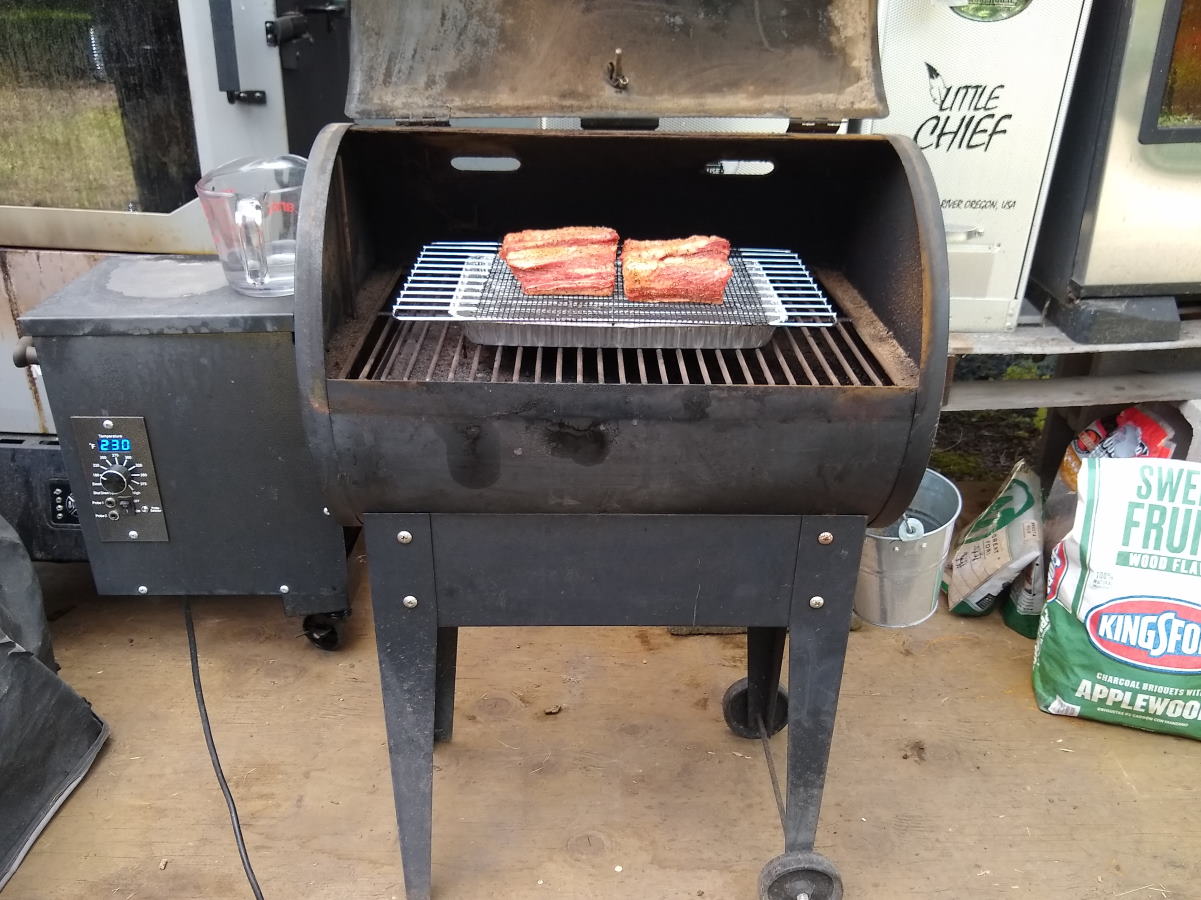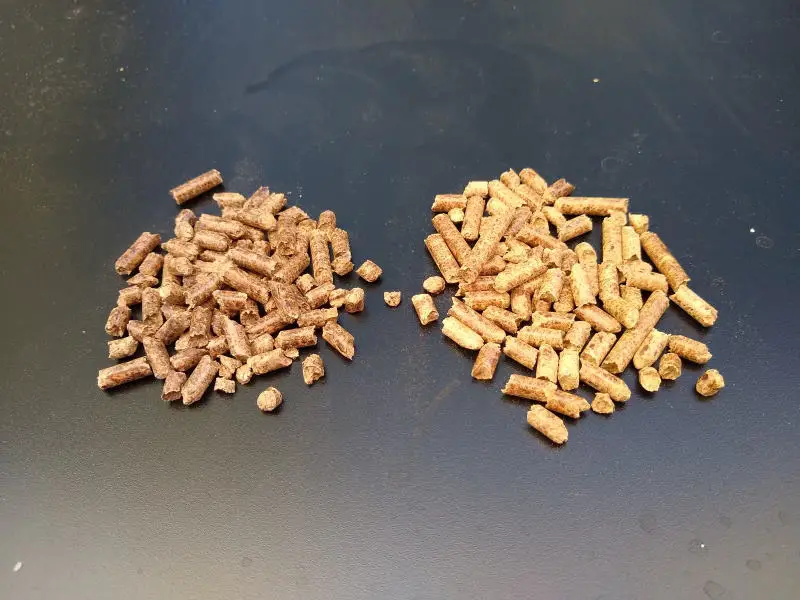
There’s just something about cooking outdoors. Everyone loves the feeling of being a “grill master” for a backyard gathering — firing up the grill, timing when your meat is done to match mealtime, making fine adjustments to preserve flavor, and finally serving up a helping of deliciousness for all your guests. And your pellet smoker (a.k.a. pellet grill) is king, but does it need a water pan?
Pellet smokers do not need a water pan to produce great results. Most experts will tell you a water pan is unnecessary to add moisture to your food. However, water pans can be an excellent place for drippings to fall and prevent scorched or burnt flavors. Also, a water pan can be used to catch drippings for a barbecue sauce or smoky gravy.
In this post, we’ll talk about the benefits and hazards of adding a water pan to your pellet-grill apparatus, as well as the history and origins of pellet smokers and how they’ve come to a place of prominence in many chefs’ lives. We’ll also answer the most commonly asked questions and give you a complete picture of using a pellet smoker for cooking in general.
Note: most links in this article are Amazon.com Affiliate links, see Affiliate Disclosure, thank you.
What Is a Pellet Smoker and How Does It Work?
Before we get into the finer details of pellet-grill cooking, let’s take a look at the equipment itself, its advantages, and where it fits in the backyard grilling milieu.
A pellet smoker operates on the convection-cooking principle and consists of a grill unit with a side-mounted pellet hopper. It includes an electric-powered auger to distribute the desired amount of pellets to the burning area(firepot), an igniter rod to light the pellets, and an electric fan that introduces enough air to burn at the desired temperature. But how did the technology come about?
Click here to read our article How Does a Pellet Smoker Work
Pellets First Appeared During the 1970s Oil Crisis
Are you old enough to remember the gas station lines of the Carter administration? People had to drive to service stations to fill their tanks and, before pulling up to the pump, had to wait in lines that stretched around the block, sometimes while already running on fumes. There was more than one situation where a consumer ran out of gas waiting in line.
So, due to the rarity and high cost of heating oil, there came a demand for alternative energy sources — among them, the wood pellet stove for heating homes. There was already a precedent for pellet production, as animal-feed pellets had been around for a while. Hence, it was a simple matter to adapt the process into wood-pellet production. Pellet stoves made a splash when it came to avoiding high heating oil costs.
Pellets Enjoyed a Resurgence in the 1990s
When the U.S. pulled itself out of the oil crisis, demand for wood pellets declined. It wouldn’t be until the hole in Earth’s ozone layer was discovered and people clamored for alternative energy sources to combat climate change that these eraser-sized chunks of compressed sawdust truly came into their own.
In the intervening years, Oregon businessman Joe Traeger and Boeing aviation engineer Joe Whitfield both came out with pellet-fueled stoves for heating homes. Traeger invented a pellet-fueled grill (pellet smoker) that operated on his stove’s same principles — electric auger, ventilation fan, ignition rod, and convection capability. Traeger’s patent on the grill let him corner the market, with many competitors emulating his style when the patent expired in 2006.

Hardwood-Only Pellets: The Icing on the Cake
By the 1990s, competition between pellet-smoker manufacturers was fierce. One side effect of this open-market race was the development of food-grade pellets. The old heating-style pellets contained hardwood, softwood, and bark scraps.
Most softwoods and softwood bark scraps are not food safe and adversely affect the quality and taste of foods. This phenomenon urged the invention of hardwood-only pellets that would be perfect for cooking.
The added benefit of hardwood-only pellets is the ability of hardwood smoke to enhance the flavor of foods. Most types of hardwood — including hickory, maple, cherry, and apple woods — will add a unique element to the taste of the food in a pellet smoker, the same way a traditional smoker will. Plus, without the softwood and bark material, there are no unwanted flavor elements.
Today, thousands of grill users swear by their pellet smokers. A cottage industry of grilling competitions using pellet-fueled grills has popped up in the U.S. and beyond. It’s safe to say that this type of cooking equipment is here to stay.
Check out our article All About Wood Pellets
Should I Use a Water Pan in a Pellet Smoker?
Once you’ve mastered the heat and temperature settings and cooking times on your pellet smoker, there may remain a feeling that you can control your cooking outcomes even further. If you add a water pan under your grill, will your meat come out better?
Adding Moisture and Juiciness With a Water Pan
Many backyard barbecue masters assume that if they add extra moisture to the grilling process using a water pan inside the cooker, their meat will benefit from having that moisture cooked in. That is, it’ll come out of the grill with an extra boost of juiciness.
However, there are a couple of reasons that indicate that extra water is not needed:
In short, a quick scan of pellet-smoker discussion boards indicates that the extra humidity from a water pan doesn’t make all that much of a difference.
Preventing Scorched Drippings With a Water Pan
It turns out that it’s quite a common thing for meat drippings to drop onto the bottom grease-drip pan of a pellet smoker and be burnt, causing ill-flavored smoke to change the taste of the food being cooked.
Watch this video from Heavy Metal Bar-B-Que about using a water pan to catch drippings:
You can see and hear that even if you cover your grease-drip pan with aluminum foil, drippings can still scorch and release foul-tasting smoke inside your pellet grill.
To solve this problem, the Heavy Metal professional takes a roast pan like the DOBI Aluminum Disposable Foil Pans from Amazon. They poke holes around the side of the pan to encourage even distribution of hot convection cooking air. Then, they set it directly beneath the actual grill with about an inch of water in the pan.
At the end of the video, you can see how the water pan has caught the drippings from the half turkey breast the pro has cooked, preventing any “flavor damage” to the meat itself. You don’t have to be a purist to realize what a benefit it is to preserve the natural taste of your grilled meat — and the subtle enhancement conveyed by your hickory or applewood pellets.
We like to place the foil pan directly on the grill grate and place or rib rack in the cent to raise the food for good air circulation. Remember that the temperature will be slightly higher in this location so keep a close eye on your food.
Cleanup When using a Water Pan in a Pellet Smoker
If you choose to use a water pan in a pellet smoker to add moisture or catch dripping, here are a few steps to complete your cleanup. These steps will take advantage of the moisture and eliminate the pitfalls of the extra moisture.
- When finished cooking, use your wire coil brush or lava rock cleaner to scrape the grates clean. The extra moisture makes it easy to clean before any droppings harden up.
- Run your grill on high for 15 minutes to evaporate all the moisture. Residual moisture can cause rust or mold to form in your pellet grill.
- Empty your pellet hopper to eliminate the possibility that any pellets have absorbed any moisture.
Steps 2 and 3 can be done in combination. Remove most of the pellets from your pellet grill. Restart your grill and run at a high temperature until all the pellets have been used.
Final Thoughts
The general consensus on using a water pan in your pellet smoker is that it’s unnecessary if all you’re worried about is retaining your meat’s natural moisture. Still, it does come in handy for avoiding any extraneous foul-smelling fumes during the cooking process.
Of course, it’s all a matter of personal preference. We recommend doing some experimentation on your own to find the perfect mixture of pellet-grilling components for you and your family. Whatever you do, be safe, have fun, and take advantage of whatever warm weather is forthcoming in your climate region. Best of luck!
FAQ
Can I Use the Drippings from a Pellet Smoker Water Pan?
The drippings from your pellet smoker water pan will make a great addition to a barbeque sauce or a smoky gravy. While cooking your food in your pellet smoker, try to maintain the water pan with the minimum amount of water. The goal is to prevent your drippings from burning but not have your final product watery. Finally, avoid scraping crispy bits into your pellet smoker water pan and filter your juices with a sifter.
